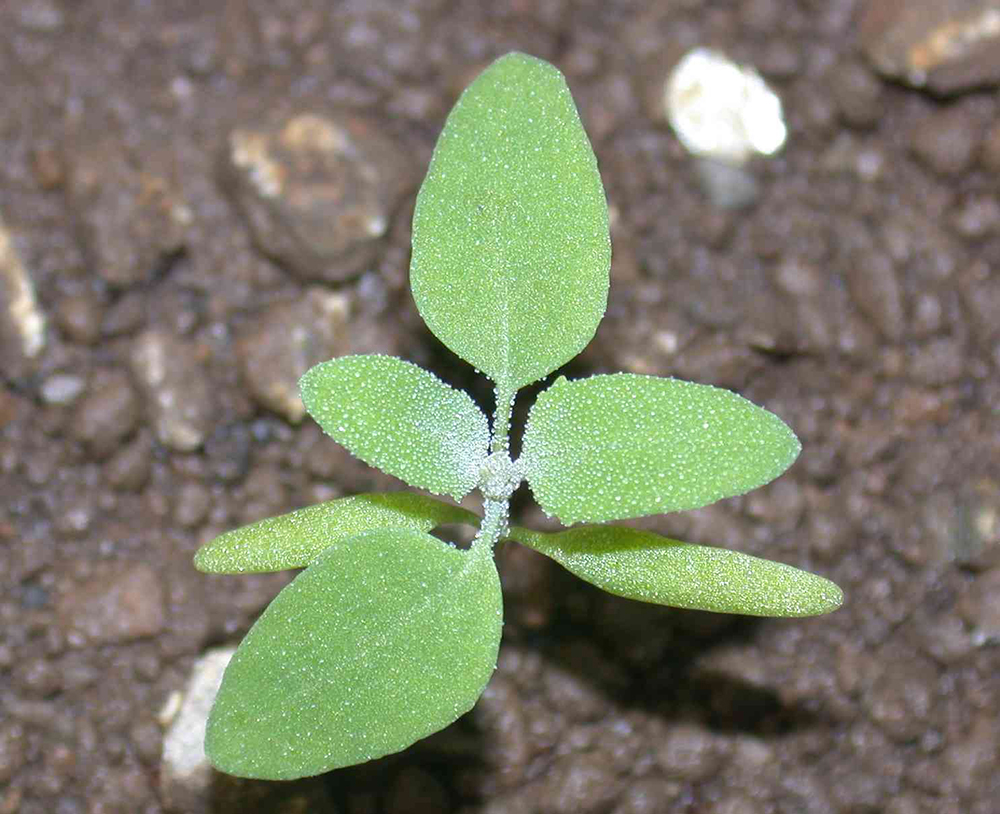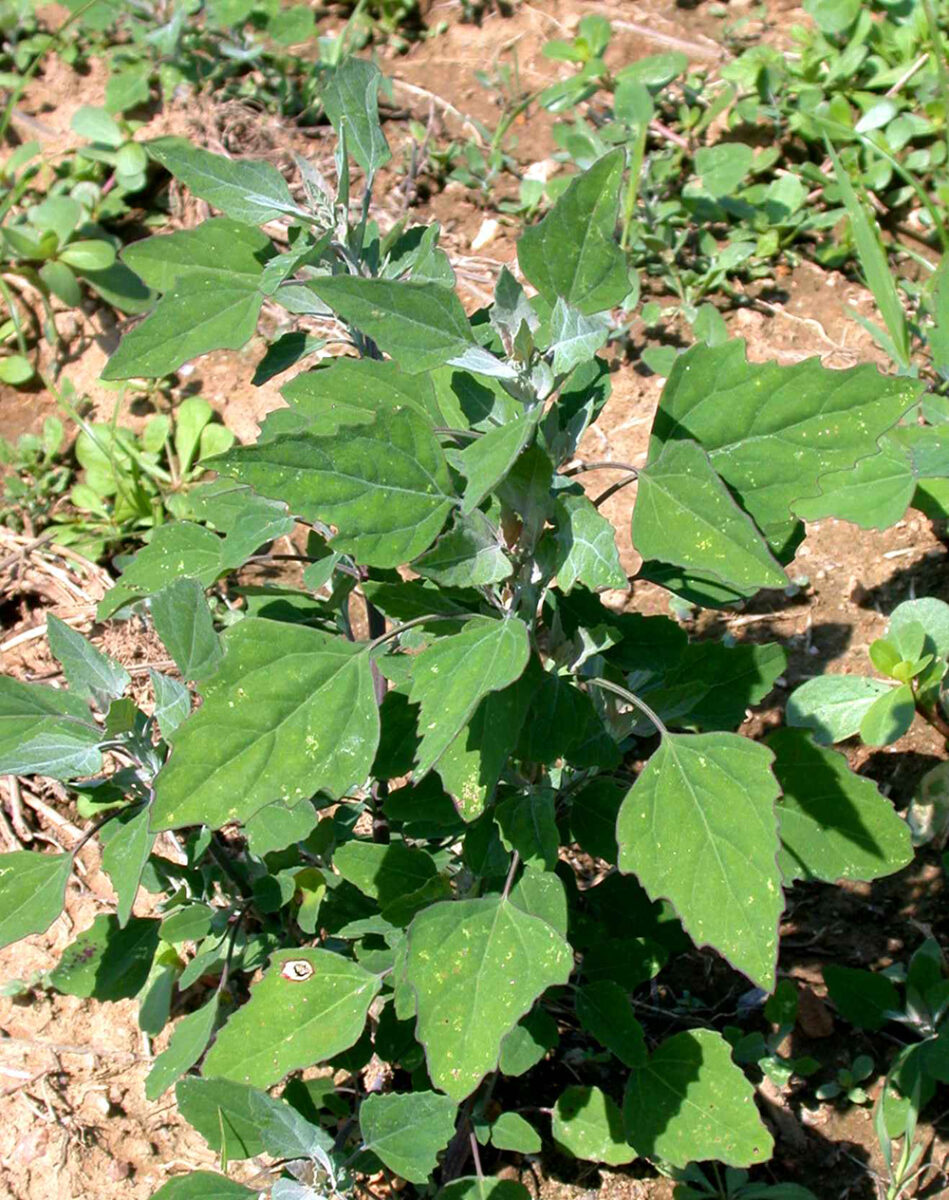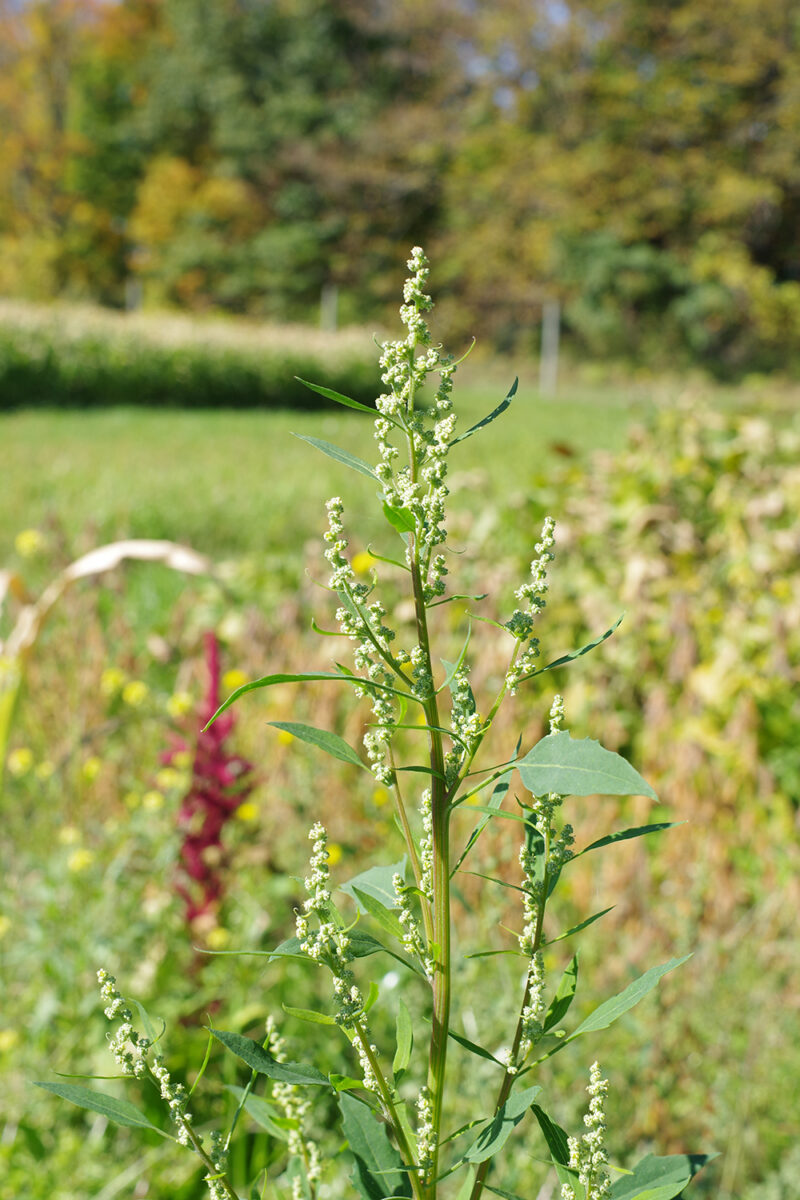Other common names: white pigweed, white goosefoot, pigweed, fat hen, mealweed, frost blite, frost bite, bacon weed, lamb's quarters, lambsquarter, lambs quarter, lambs quarters, goosefoot, netseed lamb’s quarters, wild spinach, green pigweed



Chenopodium album L.
Identification of Lambsquarters
Family: Goosefoot family, Chenopodiaceae
Habit: Tall, erect, summer annual herb
Description: Seedlings have thumb- to long ellipse-shaped, 0.16–0.6 inch long by 0.04 inch wide cotyledons. Upper sides of cotyledons are dull green; seedling stems and undersides of cotyledons are maroon-green. The first two leaves are egg shaped and opposite; all subsequent leaves are alternate, although the first few leaves may appear opposite. Young leaves have a silvery or pink, grainy or mealy coating. The diamond-to-egg-shaped young leaves arise from a silvery to light green, mealy stem; leaf edges are either entirely or lightly toothed. Stems of mature plants are upright, pyramidal, highly branching, hairless, ridged, maroon-speckled and can reach 3–5 feet tall. Leaves are alternate, 1.2–4 inches long by less than 3.5 inches wide, green, and diamond or egg to triangle shaped, with mealy undersides. Lower leaves are broader, longer and usually toothed and stalked. Upper leaves are sometimes lanceolate, stalkless and toothless. The taproot is short and branched. Individual flowers are very small, inconspicuous and silvery to green; they are clumped together in dense clusters located in stem-leaf junctions and at branch tips. Seeds are round, black and 0.06 inch wide, or they can be brown and slightly larger with a flatter oval shape. Papery flower tissue closely coats most of the seed surface at dispersal.
Similar species: Halberdleaf orach (Atriplex patula L.) is similar to common lambsquarters and has a white mealy bloom on young growth. Halberdleaf orach is shorter and bushier than common lambsquarters, and its leaves are generally more lanceolate, less toothed and often have a pair of narrow lobes near the base of the leaf blade. Common lambsquarters seedlings are sometimes confused with several young pigweed species (Amaranthus spp.). Young, true leaves of common lambsquarters seedlings have a grainy or fuzzy, silver to pink bloom when they first emerge, but pigweed seedlings do not. Mature common lambsquarters leaves generally have toothed, sculpted edges while pigweeds have generally oval shaped, untoothed leaves. Other Chenopodium spp. do not have mealy young tissues, diamond- to egg-shaped leaves and light colored, succulent looking stems.
Management of Lambsquarters
Common lambsquarters germinates readily in response to tillage and cultivation. More than most weed species, a one- to two-week lag between initial and final seedbed preparation is effective at flushing out and destroying seedlings. A short fallow in the spring with repeated surface cultivation causes even greater depletion of the surface seed bank. The key is to use progressively shallower tillage, with the final seedbed prepared to a depth of no more than 1.5 inch. The species rarely emerges from deeper than that, and deeper tillage will raise seeds into the near-surface zone favorable for germination. Continue killing seedlings after crop planting by tine weeding with blind cultivation. Once the crop is large enough to tolerate inter-row cultivation, hill up slightly when the lambsquarters seedlings are still in the early seed-leaf stage. Even crops like cabbage and tomatoes that are not normally hilled will tolerate 1 inch of soil against the base, and this is sufficient to bury the tiny seedlings. Continue hilling with subsequent cultivations if the crop will tolerate it.
In spring and fall planted grains, a dense, uniform and vigorous stand is critical for maximizing the crop’s initial competitive advantage. Light harrowing just as the lambsquarters seedlings begin to emerge can substantially reduce density of the weed, but any substantial reduction in stand density of the grain is likely to prove counterproductive.
Straw mulch and other mulch materials are highly effective for suppressing this species since its small seeds provide few resources for pushing the seed leaves up out of the mulch mat. Because the seed leaves stay together in a vertical position until they reach the light, however, a few seedlings will usually penetrate at least 2 inches of loose straw, so either use a deeper mulch layer or compact the mulch after application.
Common lambsquarters is highly responsive to N fertility. Avoid excess fertilization, and, in particular, avoid heavy fertilization before the crop is well established. On the other hand, incorporation of a legume cover crop can enhance seed bank decline of this species by triggering fatal germination of buried seeds.
Because common lambsquarters is a prolific producer of long-lived seeds, consistent efforts to limit seed production will greatly assist long-term management. Since most seeds remain on the plant long after they mature, they can be captured or destroyed during combine harvest. Clean up fields promptly after harvest if this weed is present. If possible, remove plants that have flowered, as they can continue to form seeds even after mowing or light tillage that leaves the flowering stalks on the soil surface. Hand rogue at least the larger plants out of intensive vegetable systems. Many of the seeds remain on the plant until early winter, so fall cleanup after harvest can reduce lambsquarters density the following year. In a long-term vegetable crop rotation, seed banks of common lambsquarters tended to decrease with deep plowing to 14–16 inches but increased with rotary tillage or shallow plowing to 6–7 inches. Despite the potential longevity of common lambsquarters seed banks, the species can be virtually eliminated from a field through proper crop rotation coupled with other good management practices.
Ecology of Lambsquarters
Origin and distribution: Common lambsquarters was introduced from Europe. It is present in all 50 states and in all Canadian provinces and territories except for Nunavut. It has been introduced throughout the world and is widespread from 70° N to 50° S except in extreme deserts.
Seed weight: 0.5–0.7 mg depending on the population and type of seed; the same plant may produce several types of seeds with different size and dormancy characteristics.
Dormancy and germination: Common lambsquarters frequently produces two or more visually distinct types of seeds on the same plant, and these differ in their dormancy properties. Many seeds are usually dormant immediately after falling from the parent plant, but some are not. A period of cold, wet conditions breaks dormancy, and warm weather in early spring promotes subsequent emergence. Seeds produced under short day-length conditions are less dormant than those produced during long days. Common lambsquarters germination is substantially increased by white light but is inhibited by light depleted in red wavelengths, such as light that has passed through a plant leaf canopy. Germination is increased by the presence of nitrate and by large day/night temperature fluctuations. The germination promoting effects of light, nitrate and fluctuating temperature act together such that more seeds germinate with two of these cues than with one, and maximum germination is usually reached when the seeds receive all three cues. All of these cues tend to occur during or shortly after tillage. Seeds from plants grown in high nitrate conditions have higher N concentrations and higher germination rates than seeds from unfertilized soil. Seeds germinate best with daytime temperatures of 64–77°F. The process of germination begins at temperatures as low as 43°F, but relatively few seeds germinate below 55°F or above 91°F. A few weeks of exposure to temperatures over 59°F causes some seeds to enter secondary dormancy, and thus, warm weather in summer induces dormancy in a substantial fraction of seeds.
Seed longevity: Common lambsquarters seeds can remain viable in the soil for many decades. As an extreme example, viable seeds have been recovered from under medieval ruins in Europe. Most seeds, however, do not last so long. In undisturbed soil, mortality rates of 8–35% per year have been observed, with most rates near the lower end of the range. In New York, annual seed mortality was variable, with a more typical average rate of 21% in one experiment but an unusually high rate of 78% in another. In long-term conventional and organic plots in the mid-Atlantic states, annual seed mortality averaged 51%. In annually tilled fields, decline in the common lambsquarters seed bank has varied from 14–42% per year, with most loss rates nearer the higher value. In soil stirred six or more times per year, seed loss was 31–52% per year.
Season of emergence: Common lambsquarters emerges throughout the growing season but with a strong peak in spring. It is categorized as an early emerging species that begins emergence in early spring, but it has one of the longest emergence durations of all weeds studied.
Emergence depth: Optimum depth for emergence is near the soil surface, 0.1–0.2 inch, and few seedlings emerge from deeper than 1.2 inch.
Photosynthetic pathway: C3
Sensitivity to frost: Common lambsquarters is sensitive to frost.
Drought tolerance: The species is relatively drought tolerant.
Mycorrhiza: The species is non-mycorrhizal.
Response to fertility: Common lambsquarters is a heavy feeder of plant nutrients. It has a strong growth response to increasing N applications up to at least 480 pounds per acre and a moderate response to P up to about 46 pounds per acre of P2O5. Plants grew substantially larger with 5,830 pounds per acre of composted chicken manure as compared to 2,920 pounds per acre. The species concentrates N in excess of its needs, and increasing N can favor this weed relative to crops. Common lambsquarters also has a strong growth response to increasing K, and it is strongly competitive when K levels are high. The species tolerates a wide range of soil pH but tends to grow poorly on very acidic soils.
Soil physical requirements: Common lambsquarters is regularly found on all soil textures from sand to clay and peat, but it grows most vigorously on fine textured soils. It emerges best in a moderately rough seedbed. It tolerates some soil compaction and waterlogging but with reduced emergence and growth. The species tolerates salinity.
Response to shade: Common lambsquarters is intolerant of heavy shade, especially shortly after emergence. Plants react to shade by growing taller and allocating a larger proportion of tissue to stem and leaves and a smaller proportion to the inflorescence. Nevertheless, plants will still flower in dense shade, and shading that begins after the plant flowers has no effect on seed production.
Sensitivity to disturbance: Young plants are unable to survive mowing or trampling, and older plants re-grow poorly. They dry out quickly when uprooted.
Time from emergence to reproduction: Plants flower more quickly with short day lengths than with long days. Flowering occurred five to six weeks after emergence in Canada and 81 days after emergence in Wisconsin. Some seeds become viable within two weeks of flowering, and most are viable within three weeks. Early maturation may be triggered by protracted drought. Mature seeds usually remain on the plant for weeks to months before being released.
Pollination: Common lambsquarters is self pollinated or wind pollinated.
Reproduction: The plants set seeds over a relatively short period as they mature. A small plant (about 1 foot) can produce several hundred seeds, and large plants can produce more than 100,000 seeds. Plants growing at low density with cabbage, onions or without a crop produced 30,000–370,000 seeds per plant, plants in soybeans produced 30,000–175,000 seeds per plant, plants in corn produced 8,000–117,000 seeds per plant, and plants in rapeseed produced 175–2,250 seeds per plant. Within each of these crops, most variation was due to differences in growing conditions between years. Plant size at maturity decreases as the date of emergence is delayed, and seed production is closely correlated with total plant weight.
Dispersal: Because seeds of common lambsquarters often reach high densities in soil, they are easily spread between sites by soil clinging to large animals, shoes, tires and machinery used for farm operations and road construction. Seeds have been spread in ship ballasts. The seeds survive well in the digestive tracts of cows, sheep and pigs, and manure is commonly contaminated with common lambsquarters seeds. Some seeds will pass through chickens, sparrows and ducks. Seeds also disperse in streams and irrigation water.
Common natural enemies: In wet weather, damping-off fungi can kill large numbers of lambsquarters seedlings, particularly if they are shaded by a crop or mulch. Leaf miner damage (curved tracks on the leaves) is commonly observed but is rarely severe enough to check the weed’s growth.
Palatability: Young lambsquarters are highly palatable and can be used as a salad green or pot herb. The foliage is high in vitamin C, carotenoids and essential minerals. Seeds and dried flower heads can be ground and added to soups and breads. The cleaned seeds can be cooked as a grain or ground for flour. Plants can, however, contain oxalic acid and nitrate and can be toxic to sheep and pigs if large amounts are consumed rapidly.
Summary Table of Lambsquarters Characteristics
| Common lambsquarters | ||||||||
|---|---|---|---|---|---|---|---|---|
| Growth habit | Seed weight (mg) | Seed dormancy at shedding | Factors breaking dormancy | Optimum temperature for germination (F) | Seed mortality in untilled soil (%/year) | Seed mortality in tilled soil (%/year) | Typical emergence season | Optimum emergence depth (inches) |
| tall, erect | 0.50–0.72 | Yes | cms, li, at, ni | 64–77 | 8–51 | 31–52 | early spring to summer | 0.1–0.2 |
| Photosynthesis type | Frost tolerance | Drought tolerance | Mycorrhiza | Response to nutrients | Emergence to flowering (weeks) | Flowering to viable seed (weeks) | Pollination | Typical & high seed production (seeds per plant) |
| C3 | low | moderate | no | high | 5–12 | 2–3 | both | 30,000 & 300,000 |
Table Key
General: The designation “–” signifies that data is not available or the category is not applicable.
Growth habit: A two-word description; the first word indicates relative height (tall, medium, short, prostrate) and second word indicates degree of branching (erect, branching, vining).
Seed weight: Range of reported values in units of “mg per seed.”
Seed dormancy at shedding: “Yes” if most seeds are dormant when shed, “Variable” if dormancy is highly variable, “No” if most seeds are not dormant.
Factors breaking dormancy: The principle factors that are reported to break dormancy and facilitate germination. The order of listing does not imply order of importance. Abbreviations are:
scd = seed coat deterioration
cms = a period subjected to cold, moist soil conditions
wst = warm soil temperatures
li = light
at = alternating day-night temperatures
ni = nitrates
Optimum temperature range for germination: Temperature (Fahrenheit) range that provides for optimum germination of non-dormant seeds. Germination at lower percentages can occur outside of this range. The dash refers to temperature range, and the slash refers to alternating day/night temperature amplitudes.
Seed mortality in untilled soil: Range of mortality estimates (percentage of seed mortality in one year) for buried seeds in untilled soil. Values were chosen where possible for seeds placed at depths below the emergence depth for the species and left undisturbed until assessment. Mortality primarily represents seed deterioration in soil.
Seed mortality in tilled soil: Range of mortality estimates (percentage of seed mortality in one year) for seeds in tilled soil. Values were chosen for seeds placed within the tillage depth and subjected to at least annual tillage events. Seed losses are the result of dormancy-breaking cues induced by tillage, germination and deterioration of un-germinated seeds.
Typical emergence season: Time of year when most emergence occurs in the typical regions of occurrence for each weed. Some emergence may occur outside of this range.
Optimum emergence depth: Soil depths (in inches below the soil surface) from which most seedlings emerge. Lower rates of emergence usually will occur at depths just above or just below this range.
Photosynthesis type: Codes “C3” or “C4” refer to the metabolic pathway for fixing carbon dioxide during photosynthesis. Generally, C3 plants function better in cooler seasons or environments and C4 plants function better in warmer seasons or environments.
Frost tolerance: Relative tolerance of plants to freezing temperatures (high, moderate, low).
Drought tolerance: Relative tolerance of plants to drought (high, moderate, low).
Mycorrhiza: Presence of mycorrhizal fungi. “Yes” if present; “no” if documented not to be present, “unclear” if there are reports of both presence and absence; “variable” if the weed can function either with or without, depending on the soil environment.
Response to nutrients: Relative plant growth response to the nutrient content of soil, primarily N, P, K (high, moderate, low).
Emergence to flowering: Length of time (weeks) after emergence for plants to begin flowering given typical emergence in the region of occurrence. For species emerging in fall, “emergence to flowering” means time from resumption of growth in spring to first flowering.
Flowering to viable seed: Length of time (weeks) after flowering for seeds to become viable.
Pollination: “Self” refers to species that exclusively self-pollinate, “cross” refers to species that exclusively cross-pollinate, “self, can cross” refer to species that primarily self-pollinate, but also cross-pollinate at a low rate, and “both” refers to species that both self-pollinate and cross-pollinate at relatively similar rates.
Typical and high seed production potential: The first value is seed production (seeds per plant) under typical conditions with crop and weed competition. The second value, high seed production, refers to conditions of low density without crop competition. Numbers are rounded off to a magnitude that is representative of often highly variable reported values.
Further Reading
Bassett, I.J. and C.W. Crompton. 1978. The biology of Canadian weeds. 32. Chenopodium album L. Canadian Journal of Plant Science 58: 1061–1072.
Henson, I.E. 1970. Effects of light, potassium nitrate and temperature on the germination of Chenopodium album L. Weed Research 10: 27–39.
Mohler, C.L., B.A. Caldwell, C.A. Marschner, S. Cordeau, Q. Maqsood, M.R. Ryan, A. DiTommaso. 2018. Weed seed bank and weed biomass dynamics in a long-term organic vegetable cropping systems experiment. Weed Science 66: 611–626.
Williams, J.T. 1963. Ecological Flora of the British Isles. Chenopodium album L. Journal of Ecology 51: 711–725.

